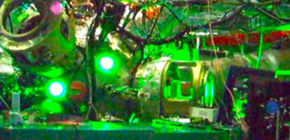
An insulator instantly turned into a fluid metal by high-power laser irradiation
Will lead to the clarification of internal structure of huge planets and smarter laser processing
It is thought that the core of the earth is made up of a liquid iron alloy under high-pressure and high-temperature (300GPa and 5,000 degrees C). Most of the interior of Jupiter is liquid hydrogen and is thought to have central pressures and temperatures of up to 3,500 GPa and 20,000 degrees C . These materials at extremely high pressures and temperatures are called ‘Warm Dense Matter (WDM)’ in the physical world. Warm dense matter is neither solid, liquid, nor plasma, so its characteristics and behavior have not been clarified. WDM is being studied all over the world not only to clarify the mystery of the inner structure of the planet, but also to contribute to the development of material science and material engineering.
In a joint research project with Dr. W. Nellis at Harvard University, Dr. M. Knudson at Sandia National Laboratories, and Dr. R. Ahuja at Uppsala University, a group of researchers including Associate Professor OZAKI Norimasa and Professor KODAMA Ryosuke at the Graduate School of Engineering, Osaka University, and Professor MASHIMO Tsutomu at the Institute of Pulsed Power Science, Kumamoto University, clarified that an insulation compound immediately turned into a fluid metal at a super high pressure and temperature of 1,000 GPa and 10,000 degrees C by using the high power laser Gekko XII at Osaka University’s Institute of Laser Engineering.
With a laser shock using light convergence, chemical compounds are cut in one 100 billionth of a second, and at the same time, the distance between atoms rapidly shrinks, producing a liquid metal state, a kind of ‘atomic soup at super high temperatures and pressures.’
This group also clarified that with increasing temperature and pressure, the characteristics of matter attributable to constituent elements of a compound and the types of chemical bonds were lost little by little, and that eventually, this led to systematic behaviors of fluid metals in accordance with the equation of state (EOS).
This group verified that making simpler classifications and understanding materials in a high energy state was possible, although it was thought to be very complex. This group’s achievement will contribute to promoting the efficacy of high-energy laser processing through its more intelligent control, the clarification of the inner structure and evolving process of huge planets to be found outside the solar system, as well as the prediction of high-density plasmas’ behavior toward the realization of laser-fusion power generation.
Abstract
Materials at high pressures and temperatures are of great current interest for warm dense matter physics, planetary sciences, and inertial fusion energy research. Shock-compression equation-of-state data and optical reflectivities of the fluid dense oxide, Gd 3 Ga 5 O 12 (GGG), were measured at extremely high pressures up to 2.6 TPa (26 Mbar) generated by high-power laser irradiation and magnetically-driven hypervelocity impacts. Above 0.75 TPa, the GGG Hugoniot data approach/reach a universal linear line of fluid metals, and the optical reflectivity most likely reaches a constant value indicating that GGG undergoes a crossover from fluid semiconductor to poor metal with minimum metallic conductivity (MMC). These results suggest that most fluid compounds, e.g., strong planetary oxides, reach a common state on the universal Hugoniot of fluid metals (UHFM) with MMC at sufficiently extreme pressures and temperatures. The systematic behaviors of warm dense fluid would be useful benchmarks for developing theoretical equation-of-state and transport models in the warm dense matter regime in determining computational predictions.

Figure 1. The moment of the high-power laser irradiation. Scientists observe the reactions of material that occurs in the interior of the 2-meter diameter vacuum chamber. (ILE, Osaka University)
Figure 2. The illustration of the interior structure of Earth from the NASA web page.The Earth has a liquid outer core and a solid inner core of iron alloy.
To learn more about this research, please view the full research report entitled “ Dynamic compression of dense oxide (Gd 3 Ga 5 O 12 ) from 0.4 to 2.6 TPa: Universal Hugoniot of fluid metals ” at this page of the Scientific Reports website.
Related link
